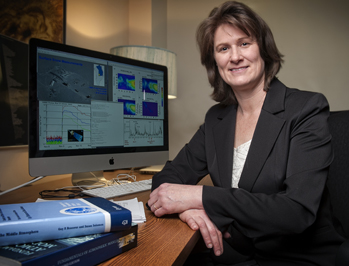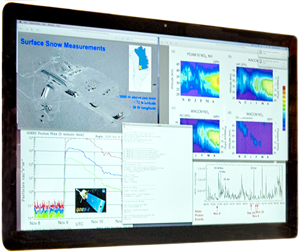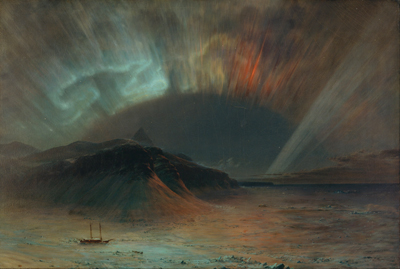Spring 2014
Space and Earth Systems Science
WHEN KATHARINE DUDERSTADT arrived at the Earth Systems Research Center just over a year ago as the newest member of the Sun-to-Ice project, she was given the task of running the Whole Atmosphere Climate Community Model (WACCM for short and pronounced "whack'em") developed by the National Center for Atmospheric Research.
Although she had done regional climate modeling in the past, Duderstadt had never worked with a large general circulation or Earth system model. Moreover, it had been more than a dozen years since she'd tackled any scientific research—her hands full instead raising two young daughters—and she had some misgivings about how much the world of mathematical modeling might have changed in her absence.
 |
||
| Katharine Duderstadt. Photo by Perry Smith, UNH Photo Services. |
||
"I had just returned to scientific research and thought it would be very difficult to learn how to use the WACCM model," Duderstadt says, "but once I started working with the code I recognized it immediately, recognized blocks of algorithms I'd used in the past. Many were the same, only vastly improved."
Duderstadt was also heartened to find both the model itself and today's modeling community surprisingly user-friendly. Not only was the Fortran code familiar and navigable but she was also able to bring herself up to speed using video tutorials and discussion boards. "These days, you can just Google a question and it will appear on some discussion board somewhere," she says.
And while her experience in regional air pollution modeling was indeed different from the big global models, she quickly learned that the under-the-hood physics and chemistry is all the same.
"So I was very excited to get a chance to learn about global climate modeling, the chemistry and dynamics of the upper atmosphere, and ice core measurements—all science I had not been exposed to but was very interested in and eager to learn."
Duderstadt has never been one to shy away from new challenges—academic or otherwise.
As a high school senior with a penchant for science, she entered a project into the prestigious Westinghouse Science Talent Search national competition, was named a finalist, and then matriculated at Harvard University to study English. That led to a stint as a Peace Corps volunteer teaching English to local teens in a Soviet-style, Hungarian factory town where the persistent acrid industrial haze made the kids asthmatic but piqued Duderstadt's interest in studying regional air pollution. Next stop, the doctoral program at the University of Michigan where she earned her Ph.D. in atmospheric and space science, and met her future husband Nathan Schwadron—now an astrophysicist in the UNH Space Science Center and team member of the Sun-to-Ice project.
Which, edited version, brings us full circle.
Putting a longstanding theory to the test, and rest
For Sun-to-Ice, Duderstadt set up the global climate model to see if it could reproduce the complex physical and chemical dynamics of an event in the upper atmosphere that creates odd nitrogen—a process that eventually produces nitric acid, which in turn can come down to the surface as snow or rain and become nitrate ion—the ultimate target the project scientists were looking for in ice cores (see "In Search of the Solar Black Swan" in this issue of Spheres).
Says Duderstadt, "When we ran the model we could not produce enough of this odd nitrogen through solar particle events so that, even if it all fell to the surface, we'd see a spike in the snow or ice. And, for the first time, our modeling was directly associated with surface snow measurements and real meteorological data so the dynamics of what we were simulating was very close to what actually occurred."
 |
|
| Elements of Duderstadt's modeling work. |
In addition, Duderstadt notes that when they compared what the model produced in the upper atmosphere to satellite measurements, it was remarkably similar in magnitude—thus further corroborating the accuracy of their findings and apparently laying to rest a longstanding scientific quest.
While the modeling work challenges the idea that nitrate spikes can provide the signature for an individual solar storm, it doesn't rule out that solar activity on time scales of centuries and millennia cannot be teased out using long-term variations in nitrate or some other proxy record such as radioactive isotopes in tree rings.
Being able to pull that out of say, carbon-14 measurements from ancient tree rings, would be important if we are to know what the sun is actually capable of. Could solar events have been orders of magnitude larger in the past, and therefore potentially devastating for today's technology-based society?
Recent tree ring studies have shown that Earth was, in fact, hit with an extremely intense burst of radiation causing a spike of radioactive carbon-14 in trees that formed around AD 775 in the Northern Hemisphere.
The cause is unknown, but scientists say the only known events that could create such a spike are supernovae explosions or proton storms from giant solar flares. A solar flare of that intensity has been ruled out because it would have vastly exceeded the most intense solar outburst ever recorded and, among other things, destroyed Earth's ozone layer.
However, some solar physicists argue that solar flares in combination with coronal mass ejections could possibly produce conditions where an unusual number of protons are accelerated to super-high energies without the flare itself being unrealistically powerful.
Carrington Event x 10?
Says Duderstadt, "Studies like the carbon-14 tree ring finding suggest there may have been much larger solar storms in the past. Could they have been fifty times greater than what we see today, which would be ten times the 1859 Carrington Event that took out telegraph lines and lit daytime skies with aurora?"
 |
||
| Frederic Edwin Church's 1865 painting "Aurora Borealis" is speculated to have been inspired by the Carrington Event of 1859. The painting is currently owned by the Smithsonian American Art Museum. |
||
For Sun-to-Ice, that research will include tweaking WACCM so that it has the ability to take energetic protons from the sun and galactic cosmic rays and generate radioactive isotopes like carbon-14. "And we'll have to figure out how to then deposit those isotopes to the surface attached to aerosols. That's what we'll start working on," says Duderstadt.
The team will also start steering the project in the direction of paleoclimate modeling in an effort to better understand the sun's influence on Earth's past climate history.
"One of the big unknowns," Duderstadt says, "is how our upper atmosphere influences climate, and we're going to link together three different models, including WACCM, to try and propagate solar flares and coronal mass ejections to see what type of energetic particles hit the top of Earth's atmosphere and then bring their influence down to the surface."
Eventually, Duderstadt hopes to get back to regional air pollution work, which also included aspects of public policy and education spurred by her original, post-Peace Corps motivation—trying to figure out where chemical factories could be located so kids don't get sick.
"But you know," she says, "you take whatever opportunities come along, and I tend to become interested in whatever I'm doing at the time. I loved teaching high school physics (which she did for four years in Newton, Mass. while Schwadron worked at Boston University), that was hard to leave, and I've loved the Sun-to-Ice modeling work."
And she's relished fulltime motherhood as well, which she compares to the famous Peace Corps slogan of "The toughest job you'll ever love."